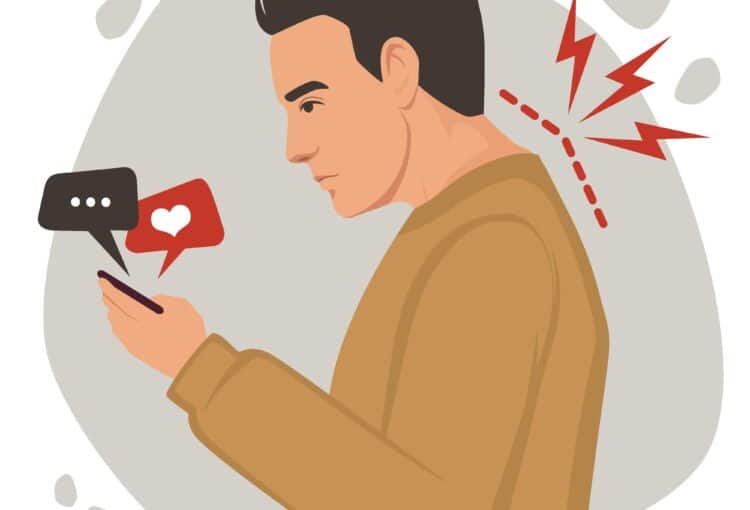What is Text Neck, and How to fix it?

Text neck is a term used to describe neck pain and stiffness that can result from constantly looking down at a mobile device or computer for prolonged periods of time. The repetitive forward head posture that is common with prolonged device use can cause strain on the neck and upper back muscles, leading to discomfort and potential long-term issues. With the increased use of technology and devices in our daily lives, text neck has become a more prevalent issue. It can be prevented through proper posture and taking breaks from device use, as well as through exercises and stretches to strengthen the neck and upper back muscles.
What Causes Text Neck Injury?
Text neck injury is caused by the repetitive forward head posture that is common with prolonged device use. When we look down at our phones, tablets, or computers for extended periods of time, the neck and upper back muscles have to work harder to support the weight of the head, which can lead to strain and fatigue.
The head weighs approximately 10-12 pounds when it is in a neutral position, but for every inch that it is tilted forward, the weight that the neck and upper back muscles have to support increases exponentially. When the head is tilted at a 60-degree angle, for example, the weight that the neck and upper back muscles have to support can increase to as much as 60 pounds, which can cause significant strain and stress on these muscles.
Over time, this repetitive strain can lead to text neck injury, which can cause pain, stiffness, and reduced range of motion in the neck and upper back. Additionally, text neck can also lead to poor posture, which can contribute to a range of other musculoskeletal issues over time.
Symptoms of Text Neck Injury
The symptoms of text neck injury can vary depending on the severity and duration of the strain on the neck and upper back muscles. However, common symptoms of text neck injury include:
- Neck pain and stiffness
- Upper back pain and stiffness
- Headaches
- Reduced range of motion in the neck
- Tingling or numbness in the arms or hands
- Shoulder pain
- Postural problems
- Difficulty sleeping
If left untreated, text neck injury can become chronic and lead to more serious issues such as herniated discs, degenerative disc disease, and arthritis. If you experience any of these symptoms, it is important to seek medical attention and take steps to prevent further injury.
Treatments for Text Neck Injury
The treatment for text neck injury depends on the severity and duration of the strain on the neck and upper back muscles. Here are some of the common treatments for text neck injury:
- Rest and Avoiding Device Use: The first step in treating text neck injury is to rest the affected area and avoid the use of mobile devices, computers or any other activities that exacerbate the pain.
- Ice or Heat Therapy: Applying ice or heat to the affected area can help reduce pain and inflammation. Ice therapy is recommended during the first 24-48 hours after injury, while heat therapy can be used after that to help relax the muscles.
- Physical Therapy: Physical therapy can help relieve pain and stiffness and improve the range of motion by using exercises and stretches that focus on the neck and upper back muscles.
- Massage Therapy: Massage therapy can help reduce muscle tension and increase blood flow to the affected area, which can help relieve pain and improve flexibility.
- Medications: Over-the-counter pain relievers such as ibuprofen or acetaminophen can help reduce pain and inflammation.
- Posture Correction: Correcting poor posture habits can help prevent future text neck injuries. Simple changes like raising the device screen to eye level, taking frequent breaks, and stretching can make a big difference.
In severe cases, surgery may be required to address more serious issues such as herniated discs or nerve compression. It is important to consult with a medical professional to determine the best treatment plan for your individual needs.
Ways to Prevent Text Neck Injury
There are several things you can do to prevent text neck injury. Here are some tips:
- Practice Good Posture: One of the best ways to prevent text neck is to maintain good posture. Keep your head upright, shoulders relaxed, and your back straight while using mobile devices or computers.
- Take Frequent Breaks: Take breaks from using mobile devices or computers to rest your neck and upper back muscles. Try to take a break every 20-30 minutes and move around or stretch.
- Use Voice-Activated Features: Many mobile devices have voice-activated features that allow you to use your device without having to look down.
- Hold Your Device at Eye Level: Try to hold your device at eye level when using it. This can help reduce the strain on your neck and upper back muscles.
- Stretching Exercises: Do regular stretching exercises for the neck and upper back muscles. This can help improve flexibility and reduce the risk of injury.
- Ergonomic Workstation: Use an ergonomic workstation, with a chair and desk that are adjustable to your height and needs. This will help you maintain a proper posture and avoid unnecessary strain.
- Strengthen Your Neck Muscles: Exercises such as neck isometrics can help strengthen the neck muscles, which can reduce the risk of injury.
By incorporating these habits into your daily routine, you can significantly reduce the risk of developing text neck injury.
Yoga – Can It Help?
Yoga can help with a text neck injury by reducing muscle tension, improving posture, and increasing flexibility in the neck and upper back muscles. Some specific yoga poses that can be beneficial for text neck injury include:
- Cow-Cat Stretch: This pose helps to stretch and loosen the neck and upper back muscles.
- Downward Facing Dog: This pose can help relieve tension in the neck and upper back muscles.
- Cobra Pose: This pose can help strengthen the neck and upper back muscles and improve posture.
- Child’s Pose: This pose can help stretch and release tension in the neck and upper back muscles.
- Shoulder Rolls: This movement can help relieve tension and improve circulation in the neck and upper back muscles.
- Eagle Arms: This pose can help stretch and strengthen the muscles between the shoulder blades, which can improve posture and reduce tension in the neck and upper back.
Yoga can also help reduce stress, which can contribute to muscle tension and exacerbate text neck injury. However, it is important to consult with a medical professional before starting any new exercise routine, especially if you have a history of neck or back problems.
A qualified yoga instructor can also help guide you through the correct alignment and modifications for any poses that may be challenging for your specific condition.
FAQs
Is Text Neck Real?
Yes, text neck injury is a real injury that can cause pain and discomfort in the neck and upper back muscles. Text neck is a condition that has become more prevalent with the increasing use of mobile devices, computers, and other screens that require the user to tilt their head downward for extended periods of time. The constant strain on the neck and upper back muscles can cause muscle imbalances, tension, and eventually lead to injury. The symptoms of text neck injury can range from mild discomfort to chronic pain and can have a significant impact on a person’s daily activities and quality of life. Therefore, it is important to take preventative measures and seek treatment if you experience any symptoms of text neck injury.
Can Text Neck Be Corrected?
Yes, text neck can be corrected with the right treatment plan and preventative measures. Treatment for text neck injury typically involves a combination of rest, physical therapy, stretching exercises, and correcting poor posture habits. By taking these steps, the muscles in the neck and upper back can be strengthened and the strain caused by poor posture can be reduced.
To prevent future text neck injury, it is important to maintain good posture, take frequent breaks from using mobile devices and computers, and incorporate stretching exercises and strengthening exercises into your routine. By correcting poor posture habits and taking preventative measures, you can avoid future injury and promote overall musculoskeletal health.
It is important to note that correction of text neck may take time, and in some cases, more severe injuries may require more intensive treatment, such as surgery. Therefore, it is important to consult with a medical professional if you are experiencing persistent symptoms of text neck injury or have any concerns about your musculoskeletal health.
How Long Does Text Neck Last?
The duration of a text neck injury can vary depending on the severity of the injury and the individual’s response to treatment. Mild cases of text neck injury may resolve within a few days or weeks with rest, stretching exercises, and correcting poor posture habits. However, more severe cases of text neck injury may take several weeks or even months to fully recover.
If left untreated, a text neck injury can become chronic and lead to long-term pain and discomfort. Therefore, it is important to seek treatment as soon as possible if you experience symptoms of text neck injury. Treatment for text neck injury typically involves a combination of rest, physical therapy, and corrective measures to address poor posture habits. By taking these steps, most people can recover from text neck injury within a reasonable amount of time and prevent future injury.
To Sum It Up
Text neck injury is a common complaint, and its prevalence is increasing as we continue to rely on mobile devices for work and leisure. It is very important to seek professional medical assistance if you suspect that you have sustained a complication from text neck injury, as serious repercussions such as herniated discs and nerve impingement can occur. Of course, preventing text neck through posture correction and other methods can avoid more serious complications arising from text neck injury. In any case, OPA Ortho can help you to identify, understand, and take steps to treat your text neck injury, by ensuring that you get the correct treatment timeously, which will ultimately lead to the fastest recovery time and getting back to normal activity as soon as possible.
At OPA Ortho, we can assist with any questions or concerns you may have regarding any type of strain or pain in your upper back, neck, and shoulders. Along with our resources that are available to help you understand the possible causes and treatment options for your text neck injury, we can also provide help in making an appointment with an orthopedic professional so that your injury can be accurately diagnosed, and correctly treated, to ultimately get you back to functioning normally. Contact us today to see how we can assist you.

